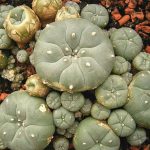 An alkaloid originally derived from the peyote cactus, resembling amphetamine and adrenaline (epinephrine) chemically; used to induce altered perceptions. Also used by native americans of the southwest in religious rites.
An alkaloid originally derived from the peyote cactus, resembling amphetamine and adrenaline (epinephrine) chemically; used to induce altered perceptions. Also used by native americans of the southwest in religious rites.
The chief psychoactive chemical found in peyote.
Hallucinogenic drug that comes from the peyote cactus.
Psychoactive alkaloid derived from a cactus (Lophophora williamsii) that produces euphoria, hallucinations, anxiety, heart palpitations, and other signs of excitement. It is used by some American Indian tribes to produce feelings of ecstasy during ceremonies, and as a street drug. Also called peyote.
Derived from the Mexican peyote cactus, Anhalonium lewinii, this is a hallucinogen used for many centuries by Indian tribes in Mexico as an intoxicant to produce ecstatic states for religious celebrations. In recent times its ability to produce temporary psychotic symptoms has been used to investigate the mechanism of psychosis. Mescaline has similar effects to those of LSD: changes in mood and thought, illusions, self-absorption and an altered perception of time. Experience of the drug may subsequently provoke panic attacks, deliberate self-injury, real psychosis and sometimes addiction.
A poisonous alkaloid, the active ingredient of the mescal buttons of the cactus plant Lophophora williamsii. It produces its euphoric effects through its impact on serotonergic neurons in the brain and causes hallucinations, especially of color and sound.
A hallucinogen obtained from the peyote cactus.
A hallucinogenic substance derived from the tops of the Mexican peyote cactus (Lophophora Williamsii).
